Selçuk Yılmaz made this lion out of
4000 pieces of scrap metal. I like how the pieces come together to form the
contours of the lion, as they help to define the musculature and show the strength of the
lion. I also appreciate all of the intricate details such as the toes and the
tail. The little directional metal pieces give him movement and interest. The
artist hand cut and hammered each piece of metal, and the lion weighs 550
pounds! The artist named him Aslan : )
Thursday, May 15, 2014
Sunday, May 11, 2014
Oakes Brick and Tile Company
My final post for this semester is about the fact that Iowa's agricultural and industrial heritage, and really that of the entire Mid-West, is inextricably linked to clay. Clay tiling (pipe) was used to drain excess water off of farmland, and also to drain low-lying wetlands in order to convert them to crop land. This innovation, along with tractors and industrial fertilizers, allowed our nation, and world, to keep up with the hunger of a rapidly growing population. Factories that produced field tile and brick were almost as common as grain mills, at the turn of the 20th century, with almost every city or town of any size having at least one.
One of the larger brick and tile factories was the Oakes Brick and Tile Factory in Iowa City, which operated from the 1850's to the 1930's. In their most successful year, I believe around 1890 or so, they 800,000 bricks and 500,000 pieces of field tile. The tiles were 3 inch wide pipes, water would drain from the fields into the cracks where 2 pieces of pipe interlocked. The pipes were made by an industrial scaled extruder, powered by steam engines. The coal that would have powered the engines and fired the kilns as well. The factory would have been located at the corner of Grant and Sheridan (coincidentally the 3 regiments of soldiers Iowa City sent to the civil war trained in the pasture beside the factory). The location was between Longfellow Elementary and Kirkwood's Iowa City Campus, with clay being dug from a quarry adjacent to Longfellow. This location would have been well into the countryside at the time. I imagine the nearby railroad tracks would have brought coal in and brick and tile out.
After World War II ceramic field tile, and load bearing brick, were replaced by cheaper materials. Most field tile today is made of pbc plastic, though I doubt it is anywhere near as durable as ceramic was.
One of the larger brick and tile factories was the Oakes Brick and Tile Factory in Iowa City, which operated from the 1850's to the 1930's. In their most successful year, I believe around 1890 or so, they 800,000 bricks and 500,000 pieces of field tile. The tiles were 3 inch wide pipes, water would drain from the fields into the cracks where 2 pieces of pipe interlocked. The pipes were made by an industrial scaled extruder, powered by steam engines. The coal that would have powered the engines and fired the kilns as well. The factory would have been located at the corner of Grant and Sheridan (coincidentally the 3 regiments of soldiers Iowa City sent to the civil war trained in the pasture beside the factory). The location was between Longfellow Elementary and Kirkwood's Iowa City Campus, with clay being dug from a quarry adjacent to Longfellow. This location would have been well into the countryside at the time. I imagine the nearby railroad tracks would have brought coal in and brick and tile out.
After World War II ceramic field tile, and load bearing brick, were replaced by cheaper materials. Most field tile today is made of pbc plastic, though I doubt it is anywhere near as durable as ceramic was.
Baby clay
This is made of polymer clay and looks so realistic that surprised me. It is little but real detail. And the color of the skin is also realistic enough to deceive people. Amazing skill as a whole.
Friday, May 9, 2014
All time favorite artist
One of my all time favorite artist is actually a painter. He is the Dutch painter Vincent van Gogh. He had a rather unique way of painting especially when catching the essence of light. He also painted a lot of landscapes, and places (inside buildings) where he spent a lot of his time and painted those as well. The way that he painted was kind of like a quick scratchy way where he would just have lines and swirls that would be divided with so much color in one place. Of course one of my all time favorite painting and famous painting would be his "Starry Night". I love the colors and how it swirls together across the whole canvas drawing your eyes into the night sky as his were when he painted it. Did you know that the famous "Starry Night", was actually the second of his starry night paintings? Yes he did one before the famous "Starry Night". It was called the "Starry Night Over the Rhone". This was a landscape view of the Rhone river where there was also a night sky but the flickering lights in the background was of houses that were very far away from the harbor. It shows a couple together walking across the beach sand where the water is washing up along the shore line. It's beautiful and I highly recommend that you take a look at it.
India
India are more sculptors but they also made clay vessels for their food. They would carve great pieces from the side of a mountain that they would tunnel through. The things that would be in there that are completely carved into the sides of the walls in their tunnels are elephants, their gods, people in everyday life settings and these would also be painted very brightly and elaborately. Then in the very back of the chamber would be the buddha they placed for worship and the tunnels that were carved in the mountains would be a temple. They also carved out/ found large brick sized rocks that they would build up to a form of a pyramid in religious values as well. They essentially created religious art.
Sculpture
Michelangelo the famous painter of the Sistine Chapel and the famous sculptor, which was his actual medium, who did the sculpting of the famous David. Michelangelo studied the human body and practiced in marble and limestone in order study and form the human anatomy and muscles. These were later portrayed in his paintings as well.
Thursday, May 1, 2014
Roxanne Jackson
Roxanne Jackson take a different approach to creating her art compared to what most people think to do. Rather than sitting down and brainstorming several ideas and ultimately picking the "best one," she just goes with what comes to her naturally, which can be tough for some. She explains that art has many roles and depicting and creating beautiful objects is not the only role art has. Therefore, Roxanne creates a lot of objects that represent the deceased. For example, she is currently working on a dead white unicorn (crystal formation for the horn) and a life-size bull made out of cement that is also dead. Roxanne states that she gets the majority of her inspiration from the National Geographic magazine, so strongly influenced by theories related to evolution.
The picture posted below is entitled Cadaver Stirrup
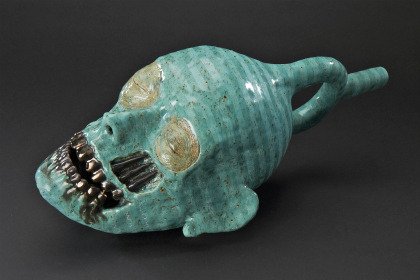
The picture posted below is entitled Cadaver Stirrup

Wednesday, April 30, 2014
Teapot by Diane KW and Corey Lum
Playing with patterns? forms? This piece is made by ceramic engineers (also known as technical ceramists), Diane KW and Corey Lum.
I don't see there's anything practical about this ceramic piece, but it's interesting to observe this knowing that it is made by "ceramic engineers." This is something that I would try when I ruin my handle or a jar.
Art work from 21st Annual Palo Alto Clay & Glass Festival
This piece is displayed in 21st Annual Palo Alto Clay & Glass Festival in July 2013. It is created by Annie Goldman. However, I loved how the artist curved holes in wide variety of sizes. It kinds of looks like a clam. I really loved this piece because of the naturally design. Even though it is made by clay, the color and the detail but random shapes of the piece gives me natural feeling that reminds of large relaxing ocean. So I like it.
Tuesday, April 29, 2014
What materials are in clay?
Raw Clay
Its primary mineral is kaolinite; clay may be generally described as 40% aluminum oxide, 46% silicon oxide, and 14% water. There are two types of clays, primary and secondary. Primary clay is found in the same place as the rock from which it is derived—it has not been transported by water or glacier and thus has not mixed with other forms of sediment. Primary clay is heavy, dense, and pure. Secondary or sedimentary clay is formed of lighter sediment that is carried farther in water and deposited. This secondary clay, a mixture of sediment, is finer and lighter than primary clay. Varying additives give the clay different characteristics. Clay comes to a production potter in one of two forms—as a powder to which water must be added, or with water already added. Large factories purchase the clays in huge quantities as dry materials, making up the clay batch as needed each day.
More info: http://www.madehow.com/Volume-4/Pottery.html#b#ixzz30Inmk8Su
Its primary mineral is kaolinite; clay may be generally described as 40% aluminum oxide, 46% silicon oxide, and 14% water. There are two types of clays, primary and secondary. Primary clay is found in the same place as the rock from which it is derived—it has not been transported by water or glacier and thus has not mixed with other forms of sediment. Primary clay is heavy, dense, and pure. Secondary or sedimentary clay is formed of lighter sediment that is carried farther in water and deposited. This secondary clay, a mixture of sediment, is finer and lighter than primary clay. Varying additives give the clay different characteristics. Clay comes to a production potter in one of two forms—as a powder to which water must be added, or with water already added. Large factories purchase the clays in huge quantities as dry materials, making up the clay batch as needed each day.
More info: http://www.madehow.com/Volume-4/Pottery.html#b#ixzz30Inmk8Su
African Pots Process
African clay is dug up either by river banks/ running water that is there all year around, or not and dug under tunnels. When the clay is dug up it is placed in a pot by those who are responsible to dig it up. In different communities it varies sometimes it only women, others is just men or both for ceremonial purposes.
When the clay is brought to the spot where they prepare the clay they separate it into little pieces where people are able to dig out bits of foreign material that doesn't belong. When the clay is separated they add a lot of water to it and let is sit so that the clay really soaks up the water. Then there is powdered material from previous pots, sand, or even straw like materials that are ground up to as finely as they can be and added to the wet clay mixture to get it to the consistency they require for making their pots. Their pots are made in different shapes and sizes depending on what they are needed for.
When the clay is ready they begin with an already made pot that they can use to create a base for the new pot. They take bits of clay and squish it together to make a line of thinned out clay so that way they can add coils of clay to their pots to be smoothed out and then fired for what ever they need.
Article I found based off of this information is http://www.gateway-africa.com/howdidthey/pottery.html
When the clay is brought to the spot where they prepare the clay they separate it into little pieces where people are able to dig out bits of foreign material that doesn't belong. When the clay is separated they add a lot of water to it and let is sit so that the clay really soaks up the water. Then there is powdered material from previous pots, sand, or even straw like materials that are ground up to as finely as they can be and added to the wet clay mixture to get it to the consistency they require for making their pots. Their pots are made in different shapes and sizes depending on what they are needed for.
When the clay is ready they begin with an already made pot that they can use to create a base for the new pot. They take bits of clay and squish it together to make a line of thinned out clay so that way they can add coils of clay to their pots to be smoothed out and then fired for what ever they need.
Article I found based off of this information is http://www.gateway-africa.com/howdidthey/pottery.html
Saturday, April 26, 2014
Well curved Flower
Clay artist is unknown but it is a tableware that is 11 in in diameter and fired to cone 10 reduction. For this piece, top of the cup where mouth is touching is well and smoothly curved. So this well-curved surface is one of my goal and part that I want to try on later.
Wednesday, April 23, 2014
Maggie Barnes
Maggie has had a life-long interest in marine life and paleontology, which came from childhood explorations with her father who was a fisherman, specifically along the Yorkshire Coast. Her passion about this type of nature is represented through her porcelain white work. She adds a smooth, fine texture to her pieces, as porcelain is described as initially a form without form or colour. She has never intended to "copy" nature, but rather capture something similar to the original inspiration.


Mary O'Mally
She made a series of bottom feeders, which are mostly ceramic cups, teapots, and saucers that are decorated with tentacles, barnacles and sea creatures. I guess I love simple ceramic pieces combined with creative forms, whether abstract or realistic figures and/or shapes.
Tuesday, April 22, 2014
Pottery and Propaganda
Today I'm posting about the Soviet Russian potter and artist Mikhail Adamovich. I knew that Soviet era social realism extended to monumental statues and murals but was not aware that it also extended into pottery as well. Most of these pieces seem to be functional dinnerware or perhaps pieces that well connected comrades would keep in their china cabinets for show or special occasions. Most of them seem to be either slip cast or made with a press, as the scale of production would have been too impractical for them to have been thrown, also they don't have the characteristic grooves. While they seem to be just a humorous novelty now, I'm sure they were anything but for those who had to live under the fear and hardships of soviet society. The detail, subject matter, technical mastery, and stylistic traits of social realism have always sparked my imagination, though one must not forget that all the modernists were probably mining coal in Siberia. There is something darkly humorous about finishing your bowl of borscht or a plate of kielbasa and boiled potatoes only to see comrade Lenin or comrade Trotsky staring up at you.
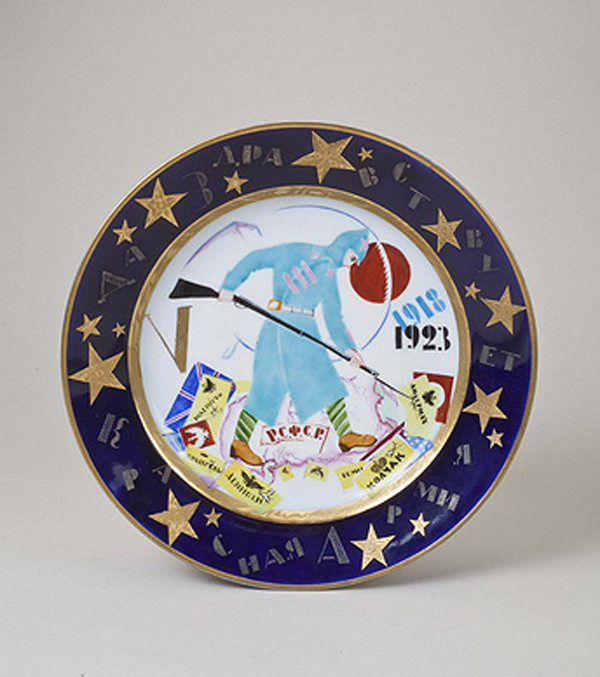
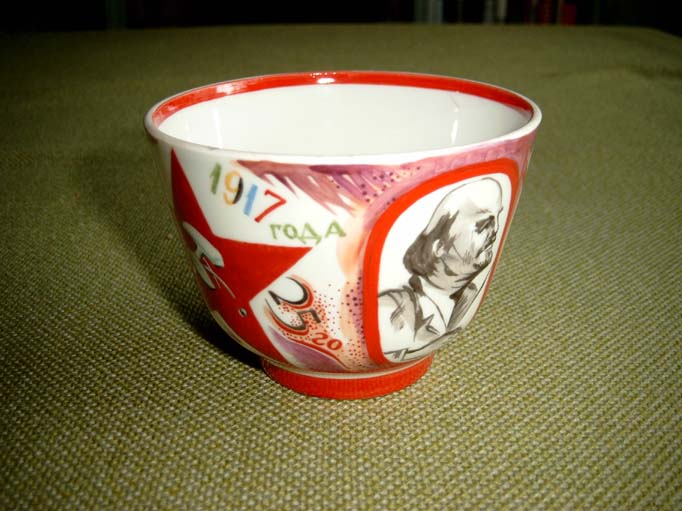






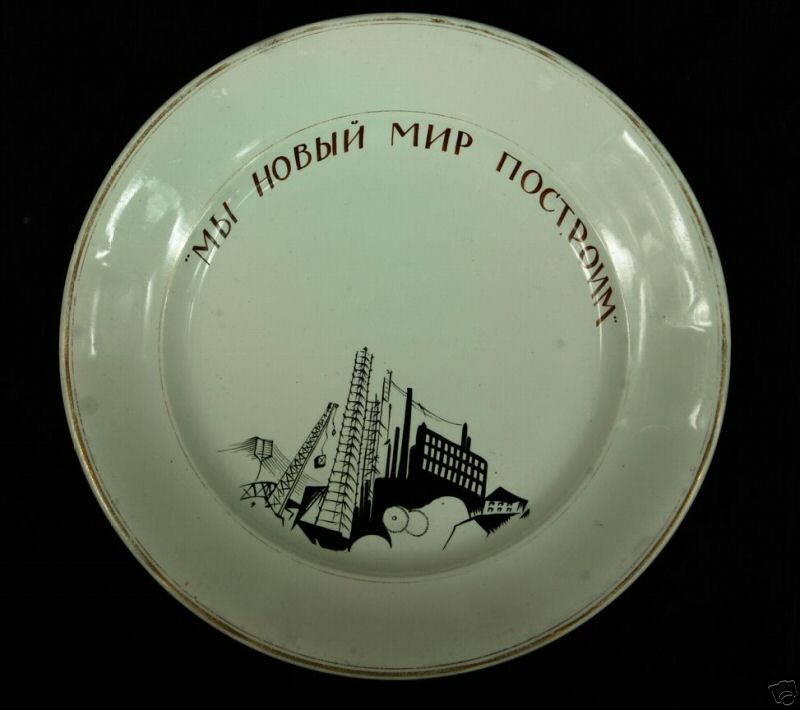







Sunday, April 20, 2014
David Pottinger
David Pottinger’s ceramics feature intricate patterns on
their surface, which are the result of a unique, meticulous process. The forms he
uses are fairly simple, usually cylinders or bowls/cups, so that the interesting
surface qualities are the main focus. Most of his pieces are handbuilt. The
artist first uses dyes to stain his clay, and then puts many, many thin layers
of the different colored clays on top of each other to create a clock. Sheets
are cut from this block and then the artist puts these sheets together to
create his forms. These pieces are interesting to look at because of their
active, complex patterns, but even more interesting when you find out the
process used to create them!
Saturday, April 19, 2014
Flip books made of bike parts by Juan Fontanive
Fontanive builds the mechanism that makes the flip book move out of bike parts and clock pieces, then meticulously hand paints and silk screens each panel. The fluttering movement of the pages is well suited to his illustrations of birds and butterflies.
The meticulous process of the machines themselves contrasts in an interesting way with this imagery, life-like animations of flittering butterflies feel precious housed in hard steel crates.
Its impressive that a flip book was turned in to an object of fine art, especially one that holds up in a gallery environment. Although flip books are generally thought of as toys, the metal housing and life-like imagery and mechanization really sets these pieces apart into the realm of fine art.
Whats most interesting about the stills to me is the placement of image, and how each panel even when the machine is off it still creates a beautiful composition.
The meticulous process of the machines themselves contrasts in an interesting way with this imagery, life-like animations of flittering butterflies feel precious housed in hard steel crates.
Its impressive that a flip book was turned in to an object of fine art, especially one that holds up in a gallery environment. Although flip books are generally thought of as toys, the metal housing and life-like imagery and mechanization really sets these pieces apart into the realm of fine art.
Whats most interesting about the stills to me is the placement of image, and how each panel even when the machine is off it still creates a beautiful composition.
Wednesday, April 16, 2014
One of China's pottery
I couldn't find the artist of this piece but I assume that it is made in old times China. I liked this piece because it has sharp but smooth line at the same time. Sharp and smooth are the opposite but this piece has both features in this piece that creates beautifulness.
Tuesday, April 15, 2014
John Neely
Monday, April 14, 2014
Brain Kakas
Brain Kakas intends to create a "new nature" in structural design by incorporating methodologies and theories from other mentioned practices. The pieces that he creates are seen to "celebrate" the versatility of clay by architectural space and dimensions. He is able to adopt continual changes in society and expresses aspects of art, technology, science and architectural theories. He is known for his work showing variations of a theme within a larger body of work. He uses multiple textures and strategies to create his uniquely beautiful pieces.
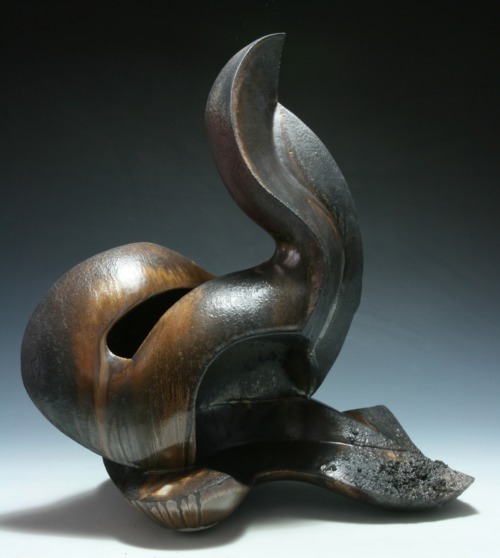

Friday, April 11, 2014
Old Korea's alcohol bottle
This is the old days alcohol bottle in Korea. These days, we are making jar and one of them, I tried to make this kind of shape but failed. The shape of the alcohol bottle has really fascinated curve line. It seems simple but beauty is in the simpleness.
Thursday, April 10, 2014
Jodi Hays
Jodi Hays is a contemporary painter who's work focuses on landscape and architecture in abstract compositions. She uses texture, color and geometry to create beautiful abstract spaces in layers of thick paint.
She varies her application of paint greatly, using tape, stencils and different tools to create new types of lines that add detail and interest to her paintings.

A lot of folks write off abstract painting as something "anyone could do" but in reality few people can combine shape and color in such skilled ways to infuse meaning and emotion in the seemingly "simple" imagery of abstract pieces.
Tuesday, April 8, 2014
Stephen Freedman
One of Freedman's abstract ceramic sculptures! I was initially drawn by the color, not the abstract form. But as I gave a closer look at this piece and other works of Freedman, they all reminded me of sea creatures. I like his abstract sculptures for no clear reason.
Figure 7 - by Stephen Freedman - 19 x 14 x 5 inches - porcelain with peachbloom - year 2012 - at Paia Contemporary Gallery
Figure 7 - by Stephen Freedman - 19 x 14 x 5 inches - porcelain with peachbloom - year 2012 - at Paia Contemporary Gallery
Monday, April 7, 2014
Easter Bowls - Carly Steuck
In the spirit of Easter, this article is a how to on to make bunny bowls. Very cute and an interesting way to make not your typical spouts and handles. Create bowls that tell a story.
Here is the link to the article: http://ceramicartsdaily.org/pottery-making-techniques/wheel-throwing-techniques/how-to-make-a-spouted-batter-bowl-that-tells-a-story/
Here is the link to the article: http://ceramicartsdaily.org/pottery-making-techniques/wheel-throwing-techniques/how-to-make-a-spouted-batter-bowl-that-tells-a-story/
Glaze: Bright Orange - Carly Steuck
Recipe Name: 72 Base with 6028 MS Orange
Cone: 6 Color: orange
Firing: Oxidation Surface:
Amount Ingredient
24 Nepheline Syenite
11 Dolomite
12 Gillespie Borate
4 Whiting
2 Zinc Oxide
7 Kaolin--EPK
40 Flint
100 Total
Peter Voulkos
Peter Voulkos is probably one of my favorite potters that I have posted about to date. Even though his medium was pottery his pieces are very sculptural in nature, as sculpture is my medium of choice, I seem to have a special affinity for his works. His pieces are very organic in both color and nature, breaking forms down to textures and geometry. His works make the maximum possible statement, using the minimum possible means in both form and expression. From the jagged edges to the muted tones, and vaguely familiar, but yet strangely foreign forms Voulkos' work captures both our attentions and our imaginations.











Subscribe to:
Posts (Atom)




















